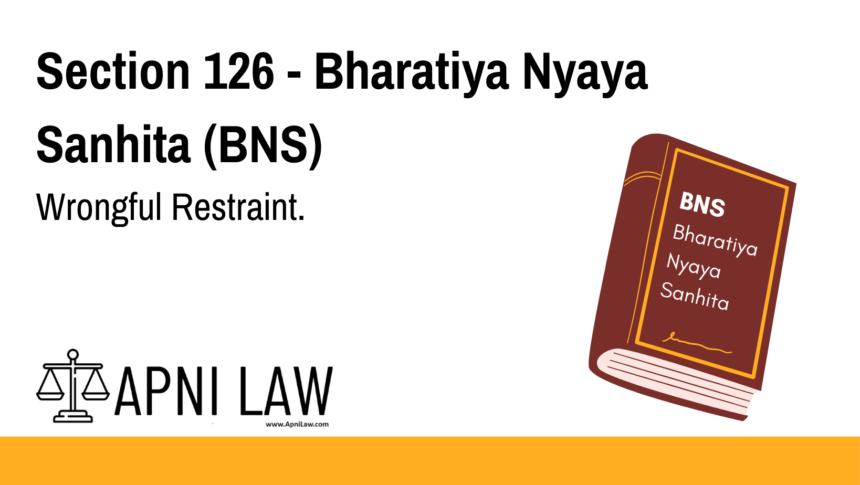Code: Section 126 BNS
Wrongful Restraint
(1) Whoever voluntarily obstructs any person so as to prevent that person from
proceeding in any direction in which that person has a right to proceed, is said wrongfully to
restrain that person.
Exception.—The obstruction of a private way over land or water which a person in
good faith believes himself to have a lawful right to obstruct, is not an offence within the
meaning of this section.
Illustration.
A obstructs a path along which Z has a right to pass, A not believing in good faith that
he has a right to stop the path. Z is thereby prevented from passing. A wrongfully
restrains Z.
(2) Whoever wrongfully restrains any person shall be punished with simple
imprisonment for a term which may extend to one month, or with fine which may extend to
five thousand rupees, or with both.
Explanation of Section 126 BNS
Section 126 of Bharatiya Nyaya Sanhita (BNS) deals with wrongful restraint, which means blocking someone’s movement in a direction where they have a legal right to proceed.
Key Provisions:
- Definition of Wrongful Restraint:
- If a person intentionally blocks another person’s path, preventing them from moving in a legal direction, it constitutes wrongful restraint.
- Exception:
- If a person genuinely believes they have a legal right to obstruct a private way, it does not amount to wrongful restraint.
- Punishment for Wrongful Restraint:
- Simple imprisonment up to one month OR
- Fine up to ₹5,000 OR
- Both imprisonment and fine
- Difference Between Wrongful Restraint and Wrongful Confinement:
- Wrongful Restraint (Section 126 BNS): Blocking someone from moving in a particular direction.
- Wrongful Confinement (Section 127 BNS): Completely restricting someone’s movement in all directions.
Illustrations
Example 1: Blocking a Public Road
A shopkeeper blocks the entrance of a public park, preventing others from entering. Since the public has a right to access, this amounts to wrongful restraint.
Example 2: Preventing Entry into a Private Property
A person stops another individual from entering their private home. This does not constitute wrongful restraint because the visitor does not have a legal right to enter.
Example 3: Unlawful Restriction of a Pedestrian
A security guard wrongfully blocks a pedestrian from using a public footpath without legal authority. This is an act of wrongful restraint under Section 126 BNS.
Common Questions and Answers on Section 126 BNS
1. What is the main purpose of Section 126 BNS?
This section is designed to protect an individual’s right to free movement. It ensures that no person is wrongfully obstructed from moving in a direction where they are legally allowed to proceed.
2. What is the punishment for wrongful restraint?
The punishment for wrongful restraint under Section 126 BNS includes:
- Up to 1 month of simple imprisonment OR
- Fine up to ₹5,000 OR
- Both imprisonment and fine
3. What is the difference between wrongful restraint and wrongful confinement?
- Wrongful Restraint (Section 126 BNS): Preventing a person from moving in one direction but allowing movement in other directions.
- Wrongful Confinement (Section 127 BNS): Completely restricting a person’s movement in all directions.
4. Can police officers restrain a person under this section?
If a police officer restrains someone lawfully, such as for investigation or security reasons, it does not amount to wrongful restraint. However, illegal restraint by police can be challenged in court.
5. Is wrongful restraint a serious offense?
Wrongful restraint is considered a minor offense and is bailable, meaning the accused can secure bail easily. However, repeated offenses may lead to harsher legal consequences.
Conclusion
Section 126 BNS is a crucial legal provision that safeguards personal freedom and mobility. It prevents individuals from being wrongfully obstructed and ensures legal accountability for unlawful restrictions.
For more legal updates, visit ApniLaw today! 🚀











